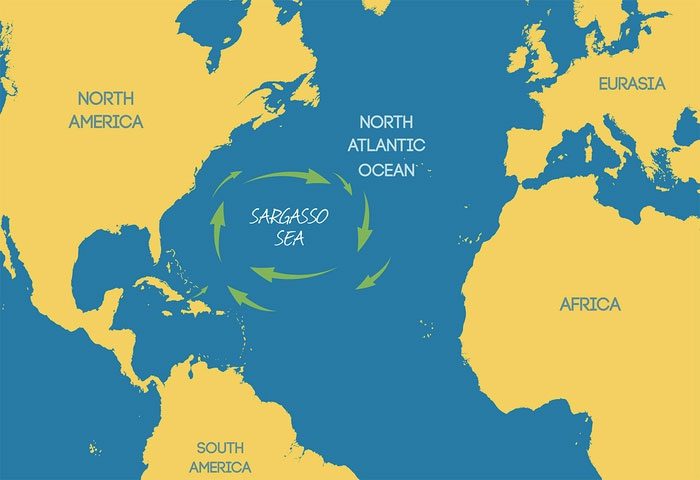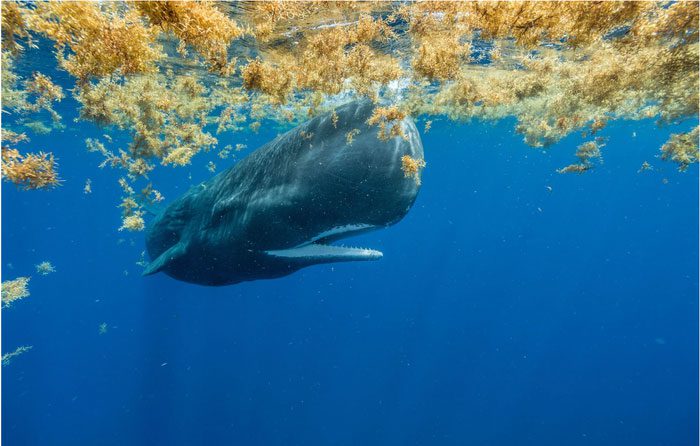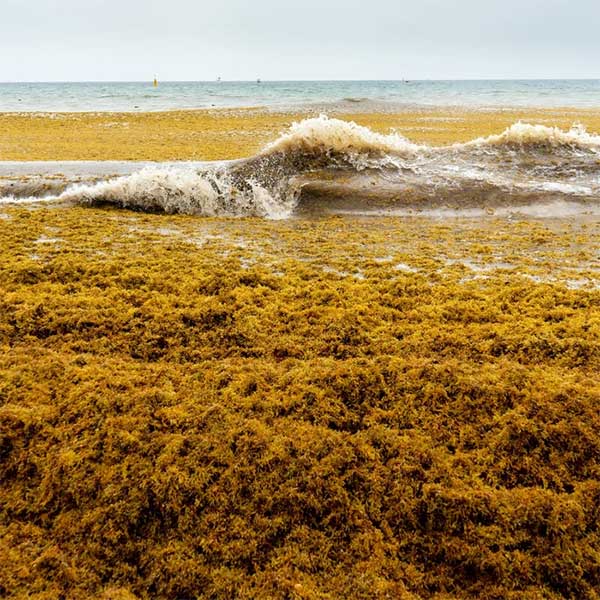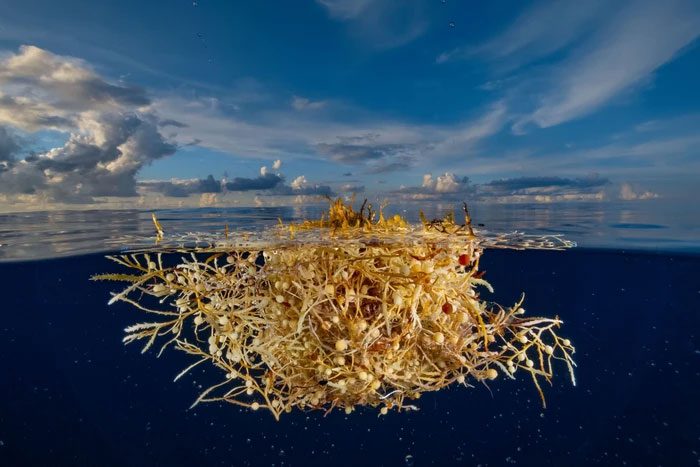The Sargasso Sea is a mysterious and dangerous region of the ocean, where sargassum algae scatter across the water’s surface, resembling mysterious graves beneath the sea, attracting many scientists for exploration and research.
In the past, Columbus was also trapped in the Sargasso Sea for a month, but eventually escaped thanks to the efforts of all the sailors. Today, scientists have uncovered many surprising truths and the dangers of the Sargasso Sea.

The Sargasso Sea on the map.
The Sargasso Sea is surrounded by four major ocean currents: the Gulf Stream to the west, the North Atlantic Current to the north, the Canary Current to the east, and the North Equatorial Current to the south. It is believed to be the only ocean region on Earth without a coastline, spanning approximately 1,126 km in width and 3,219 km in length.
Located east of the United States at the center of North Atlantic circulation, the Sargasso Sea stretches about 2,000 nautical miles long and 1,000 nautical miles wide, covering an area of more than 4.5 million square kilometers.
A large amount of floating vegetation in this sea primarily consists of sargassum algae (also known as seaweed), creating a landscape reminiscent of a meadow on the ocean. With its striking yellow color and vast quantity, these sargassum beds are often referred to as the “golden forest” of the ocean. However, this area is referred to by scientists as the “graveyard sea.” Why is that?

Large quantities of floating vegetation mainly consist of sargassum algae.
This type of algae grows very quickly in the ocean, with a growth rate of 2 to 3 cm per day and can extend over 20 meters each year. Due to its large quantity and rapid growth, the sargassum mats can cover an area equivalent to the total land area of France and Spain.
Although surrounded by strong currents, this is a calm sea with little wind, causing the waves to almost stand still. Before the advent of steam power, ships relied on the wind for movement. Thus, Columbus found himself trapped in the Sargasso Sea for a month during his journey.
The Water Environment of the Sargasso Sea
The waters of the Sargasso Sea have a unique environment, remaining calm year-round, with weak currents and minimal mixing of seawater with different water layers. This results in a very slow nutrient regeneration process in the shallow waters, which is why there are very few plankton living in the Sargasso Sea.
As a consequence, large fish and marine animals that feed on plankton can hardly survive here, and even if they do, they differ in shape and color from those in other seas. This also leads to the rarity of marine life common in other waters appearing in the Sargasso Sea.

Very few plankton live in the shallow waters of the Sargasso Sea.
The Sargasso Sea is located far from river mouths, resulting in low plankton presence and clear waters, allowing visibility to exceed 60 meters. Therefore, the Sargasso Sea is also considered the clearest sea in the world.
The Growth of Sargassum Algae in the Sargasso Sea
Sargassum belongs to the brown algae family, and the sargassum in this sea is a floating plant capable of thriving on the surface and highly adaptable. The growth rate of sargassum is rapid, capable of increasing 2 to 3 cm per day and potentially exceeding 20 meters per year.
Due to its large quantity and rapid growth, the sargassum clusters here cover vast areas—estimated to occupy a space equivalent to the combined area of France and Spain.
Because of their rapid growth, they can quickly cover the deepest parts of the ocean, even overshadowing other marine life.

The surface of the Sargasso Sea is covered with rootless green algae – sargassum.
Poor Biodiversity
Biodiversity is a crucial guarantee for the ecosystem in the region, but the biodiversity of the Sargasso Sea is very poor. The scarcity of nutrients and lack of plankton make marine life common in other seas extremely rare in the Sargasso Sea.
Organisms in this sea have adapted to the unique environment of the Sargasso Sea, forming a distinctive sargassum community, including aquatic creatures that depend on the sargassum algae and seaweed.
Except for sea turtles, whales, and a few fish species, there are very few underwater organisms here. However, if the sargassum community is damaged, it could lead to the collapse of the ecosystem.

The biodiversity of the Sargasso Sea is very poor.
Those who wish to enter the Sargasso Sea must be cautious of the North Atlantic Garbage Patch. This patch is formed when waste gets trapped between the currents of the Sargasso Sea, with up to 200,000 pieces of trash per square kilometer.
Scientific Research
Scientists have conducted long-term studies on the Sargasso Sea, seeking to understand what makes the sargassum in this area unique. They observed that sargassum in this sea would expand until it covered the entire area.
Subsequently, it transforms into dark brown algae mats that cover the sea surface and even entrap some large ships stuck here—all vessels are surrounded by these dark brown mats and cannot move.
Even giant ships that encounter disasters and spill oil drifting in these waters will have their leaks quickly covered by sargassum, helping to seal off the oil flowing from the leak and preventing it from spreading to other areas.

The Sargasso Sea is also considered the clearest sea in the world.
At one point, the Sargasso Sea was nicknamed the Horse Latitudes. This name arose because numerous ships carrying horses became trapped here for weeks, forcing crew members to throw some of them overboard to lighten the load.
Scientific studies have also indicated that when large masses of dead sargassum sink to the ocean floor, they can harm coral reefs and seagrass, adversely affecting the ecosystem on the ocean floor.
Brigitta van Tussenbroek, a researcher from the Puerto Morelos Coral Reef Systems Academic Unit in Mexico, stated to SciDev.Net: “Any phenomenon causing populations to grow out of control will create ecological imbalance. Excessive sargassum leads to oxygen depletion in the water, affecting other species and ultimately killing them. However, its negative impact doesn’t stop there.”
When decaying sargassum washes ashore and begins to decompose, it releases foul-smelling hydrogen sulfide gas (similar to the smell of rotten eggs), affecting the health of coastal residents and negatively impacting tourism and the environment.
Human Activities
Although the Sargasso Sea ecosystem is unique, it is very fragile. Due to various reasons, human activities have posed significant threats to the ecological environment of the Sargasso Sea.
The development of fishing has greatly impacted marine life in the Sargasso Sea—overfishing, exploitation, and pollution all directly affect the ecosystem in this area.
In the process, this sea has gradually become polluted and destroyed by humans, leading to the disappearance and decline of many marine species alongside human activities.


















































